The Influence of Visibility on the Opportunity to Perform Flight Operations with Various Categories of the Instrument Landing System
Abstract
:1. Introduction
2. Literature Review
2.1. Legal Background of Aircraft Accident and Incident
2.2. Aviation Incidents and Accidents Related to Weather Conditions
3. The Impact of Meteorological Conditions on Air Traffic Performance
3.1. Atmospheric Phenomena
3.2. Type of Visibility
3.3. Visibility Limitations Depending on the Phenomena
3.4. Technical Equipment
- I for a decision height of 60 m (system minima) and RVR visibility range of 550 m;
- II for a decision height of 30 m and RVR visibility range of 300 m;
- IIIA for a decision height of 15 m and RVR visibility range of 200 m;
- IIIB for a decision height of 0 m and RVR visibility range of 75 m.
4. Material and Methods
- Forecast for landing: TREND in code form. This occurs together with the current weather conditions information METAR with a validity of 2 h;
- Aerodrome forecast: TAF with a specific validity indicated in the message;
- SIGMET information: developed when significant weather phenomena such as thunderstorms, severe turbulence, severe icing, and volcanic clouds occur or are forecast to occur;
- AIRMET information: issued for low-level flights up to FL100 in the case of the occurrence or forecast of hazardous phenomena such as ground-level winds with an average speed above 60 km/h, visibility below 5000 m, thunderstorms, or low cloud base;
- Aerodrome warnings: in the case of hazardous phenomena;
- Wind shear warnings;
- Forecasts for flight crews: the forecast package includes maps of significant weather phenomena and sets of dispatches METAR/TREND, TAF, SIGMET, and AIRMET.
5. The Results of the Assessment of the Impact of the ILS Category on the Performance of Landing at Selected Airports
5.1. Short Description of the Selected Airports
5.2. Modlin Airport
5.3. Chopin Airport
5.4. Kraków Airport
6. Results and Discussion
7. Conclusions
Author Contributions
Funding
Institutional Review Board Statement
Informed Consent Statement
Data Availability Statement
Acknowledgments
Conflicts of Interest
References
- Kwasiborska, A.; Skorupski, J. Analysis of the Process of Merging Air Traffic Streams. Case Study of TMA Warsaw. In Proceedings of the Management Perspective for Transport Telematics: 18th International Conference on Transport System Telematics, TST 2018, Krakow, Poland, 20–23 March 2018; Selected Papers 18. Springer International Publishing: Cham, Switzerland, 2018; pp. 320–334, ISBN 978-3-319-97955-7. [Google Scholar]
- Kwasiborska, A.; Skorupski, J. Assessment of the Method of Merging Landing Aircraft Streams in the Context of Fuel Consumption in the Airspace. Sustainability 2021, 13, 12859. [Google Scholar] [CrossRef]
- Kwasiborska, A.; Stelmach, A. Analysis of Airport Traffic in the Context of Environmental Throughput. Transp. Probl. 2014, 9, 129–140. [Google Scholar]
- Fellner, A.; Fellner, R.; Jafernik, H. Wykonywanie lotów IFR i podejść według PBN; Wydawnictwo Politechniki Śląskiej: Gliwice, Poland, 2016. [Google Scholar]
- Alaoui, B.; Bari, D.; Bergot, T.; Ghabbar, Y. Analog Ensemble Forecasting System for Low-Visibility Conditions over the Main Airports of Morocco. Atmosphere 2022, 13, 1704. [Google Scholar] [CrossRef]
- Schultz, M.; Lorenz, S.; Schmitz, R.; Delgado, L. Weather Impact on Airport Performance. Aerospace 2018, 5, 109. [Google Scholar] [CrossRef]
- EUROCONTROL Performance Review Report—An Assessment of Air Traffic Management in Europe During the Calendar Year 2014, 2015, 2016; Technical Report; Performance Review Commission: Brussels, Belgium, 2017.
- Available online: https://www.kenyoninternational.com/Assets/Downloads/cos-fa-icao-annex-13-11-ed.pdf (accessed on 15 April 2023).
- Serious Incident. Available online: https://skybrary.aero/articles/serious-incident (accessed on 17 April 2023).
- Long, T. Analysis of weather-related accident and incident data associated with Section 14 CFR Part 91 Operations. Coll. Aviat. Rev. Int. 2022, 40, 25–39. [Google Scholar] [CrossRef]
- Novák Sedláčková, A.; Kaltman, L. Proposal for Modification of the Syllabus for ultralight Aircraft pilot’s Training. 2023. in pending of publishing. [Google Scholar]
- Škultéty, F.; Jarošová, M.; Rostáš, J. Dangerous weather phenomena and their effect on en-route flight delays in Europe. Transp. Res. Rrocedia 2021, 59, 174–182. [Google Scholar] [CrossRef]
- Wang, Y.; Kulkarni, D. Modeling weather impact on ground delay programs. In Proceedings of the SAE 2011 AeroTech Congress and Exhibition, Toulouse, France, 18–21 October 2011; Volume 4, pp. 1207–1215. [Google Scholar]
- Özdemir, E.T.; Deniz, A.; Sezen, İ.; Menteş, Ş.S.; Yavuz, V. Fog analysis at Istanbul ataturk international airport. Weather 2016, 71, 279–284. [Google Scholar] [CrossRef]
- Dagkli, V.; Karacostas, T.S. Event-based climatology and synoptic conditions associated with fog at the “Macedonia” airport. In Perspectives on Atmospheric Sciences; Springer Atmospheric Sciences Book Series; Karacostas, T., Bais, A., Nastos, P., Eds.; Springer: Cham, Switzerland, 2017. [Google Scholar] [CrossRef]
- Reynolds, D.W.; Clark, D.A.; Wilson, F.W.; Cook, L. Forecast-based decision support for San Francisco International Airport: A nextgen prototype system that improves operations during summer stratus season. Bull. Am. Meteorol. Soc. 2012, 93, 1503–1518. [Google Scholar] [CrossRef]
- Taszarek, M.; Kendzierski, S.; Pilguj, N. Hazardous weather affecting European airports: Climatological estimates of situations with limited visibility, thunderstorm, low-level wind shear and snowfall from ERA5. Weather Clim. Extrem. 2020, 28, 100243. [Google Scholar] [CrossRef]
- Taszarek, M.; Brooks, H.E.; Czernecki, B.; Szuster, P.; Fortuniak, K. Climatological aspects of convective parameters over Europe: A comparison of ERA-Interim sounding data. J. Clim. 2018, 31, 4281–4308. [Google Scholar] [CrossRef]
- Egli, S.; Thies, B.; Dr€onner, J.; Cermak, J.; Bendix, J. A 10 year fog low stratus climatology for Europe based on Meteosat Second Generation data. Q. J. R. Meteorol. Soc. 2017, 143, 530–541. [Google Scholar] [CrossRef]
- Capobianco, G.; Lee, M.D. The Role of Weather in General Aviation Accidents: An Analysis of Causes, Contributing Factors and Issues. Proc. Hum. Factors Ergon. Soc. Annu. Meet. 2001, 45, 190–194. [Google Scholar] [CrossRef]
- EUROCONTROL Algorithm to Describe Weather Conditions at European Airports; Technical Report; Eurocontrol: Brussels, Belgium, 2011.
- Available online: https://aviation-safety.net/database/record.php?id=19690124-0 (accessed on 25 May 2023).
- The Tenerife Disaster: A Cabin Crew Perspective. Available online: https://simpleflying.com/tenerife-disaster-cabin-crew-perspective/?newsletter_popup=1 (accessed on 14 April 2023).
- Garuda Indonesia Flight 152. Available online: https://www.aviationfile.com/garuda-indonesia-flight-152/ (accessed on 14 April 2023).
- Iran Ilyushin Il-76 Crash. Available online: https://military-history.fandom.com/wiki/2003_Iran_Ilyushin_Il-76_crash (accessed on 14 April 2023).
- Available online: https://incusmeteo.com/port-lotniczy-gdansk-pogoda-pokonala-system-ils/#google_vignette (accessed on 14 April 2023).
- Announcement no 34 of President of the Civil Aviation Authority from 15 June 2011 r. According Incident no 962/09. Available online: https://sip.lex.pl/akty-prawne/dzienniki-resortowe/zdarzenie-lotnicze-nr-962-09-34491283 (accessed on 14 April 2023).
- Aircraft Owners and Pilots Association. Nall Report. AOPA. 2020. Available online: https://www.aopa.org/training-and-safety/air-safety-institute/accident-analysis/joseph-t-nall-report/nall-report-figure-view?category=all&year=2017&condition=all&report=true (accessed on 19 January 2023).
- Jarošová, M.; Vojtková, J. Fog and its occurrence at the Žilina Airport. Transp. Res. Procedia 2019, 43, 251–256. [Google Scholar] [CrossRef]
- Pecho, P.; Jarošová, M.; Dvorský, R.; Škvareková, I.; Ažaltovič, V. Design of a Flight Instrument for Early Identification of Local Atmospheric Changes in the Operating Conditions of Glider. In Proceedings of the 2020 New Trends in Civil Aviation (NTCA), Prague, Czech Republic, 23–24 November 2020; pp. 51–56. [Google Scholar] [CrossRef]
- Yang, X.; Chen, Y.; Peng, L.L.; Wang, Q. Quantitative methods for identifying meteorological conditions conducive to the development of urban heat islands. Build. Environ. 2020, 178, 106953. [Google Scholar] [CrossRef]
- Valdés Díaz, B.; De Armas Echevarria, A.M.; Coll-Hidalgo, P. Main Climatic Characteristics of the International Airport “Antonio Maceo” during the Period 2017–2021. Environ. Sci. Proc. 2022, 19, 45. [Google Scholar] [CrossRef]
- Federal Aviation Administration. Aviation Safety Information Analysis and Sharing. Weather—Related Aviation Accident Study 2003–2007. 2010. Available online: https://www.asias.faa.gov/i/studies/2003-2007weatherrelatedaviationaccidentstudy.pdf (accessed on 18 January 2023).
- Gultepe, I.; Wayne, F.F. Aviation Meteorology: Observations and Models. Introduction. Pure Appl. Geophys. 2019, 176, 1863–1867. [Google Scholar] [CrossRef]
- Araghi, A.; Mousavi-Baygi, M.; Adamowski, J.; Martinez, C.J. Analyzing trends of days with low atmospheric visibility in Iran during 1968–2013. Environ. Monit. Assess. 2019, 191, 249. [Google Scholar] [CrossRef]
- Castagnos, S.; Jones, N.; Pu, P. Eye-tracking product recommenders’ usage. In Proceedings of the Fourth ACM Conference on Recommender Systems, Barcelona, Spain, 26–30 September 2010; pp. 29–36. [Google Scholar]
- Federal Aviation Administration. Advisory Circular 00-45H, Change 2, Aviation Weather Services. 2019. Available online: https://www.faa.gov/documentLibrary/media/Advisory_Circular/AC_00-45H_CHG_2.pdf (accessed on 2 December 2022).
- Kneringer, P.; Dietz, S.J.; Mayr, G.J.; Zeileis, A. Probabilistic Nowcasting of Low-Visibility Procedure States at Vienna International Airport During Cold Season. Pure Appl. Geophys. 2019, 176, 2165–2177. [Google Scholar] [CrossRef]
- Szewczyk, P. Meteorologia dla pilota samolotowego (Meteorology for Aircraft Pilot); Avia-Test Lech Szutowski: Poznan, Poland, 2010; p. 211. ISBN 978-83-931419-0-6. [Google Scholar]
- Kwasiborska, A.; Banaszek, K.; Gładyś, S.; Manerowski, J.; Reś, M. Analysis of aircraft equipment requirements to conduct RNP APCH approach operation. Syst. Logistyczne Wojsk 2021, 55, 101–120. [Google Scholar] [CrossRef]
- Instrument Landing System (ILS). Available online: https://skybrary.aero/articles/instrument-landing-system-ils (accessed on 28 May 2023).
- ICAO Annex 10—Aeronautical Telecommunications—Volume III—Communication Systems, ICAO Standards and Recommended Practices and Guidance Material, 2nd ed.; ICAO-ECP: Montréal, QC, Canada, 2007.
- Weather Observations at Aerodromes. Available online: https://skybrary.aero/articles/weather-observations-aerodromes (accessed on 28 May 2023).
- Wu, J.; Su, M.; Gong, J.; Pan, L.; Long, J.; Zheng, F. Analysis of the Influence of Flood on the L4 Combination Observation of GPS and GLONASS Satellites. Atmosphere 2023, 14, 934. [Google Scholar] [CrossRef]
- Kim, H.J.; Kim, Y.H.; Lee, J.H.; Park, S.J.; Ko, B.S.; Song, J.W. Improving the Accuracy of Vehicle Position in an Urban Environment Using the Outlier Mitigation Algorithm Based on GNSS Multi-Position Clustering. Remote Sens. 2023, 15, 3791. [Google Scholar] [CrossRef]
- Lepoglavec, K.; Šušnjar, M.; Pandur, Z.; Bačić, M.; Kopseak, H.; Nevečerel, H. Correct Calculation of the Existing Longitudinal Profile of a Forest/Skid Road Using GNSS and a UAV Device. Forests 2023, 14, 751. [Google Scholar] [CrossRef]
- Sedláčková, A.N.; Kurdel, P.; Labun, J. Simulation of Unmanned Aircraft Vehicle Flight Precision. Transp. Res. Procedia 2020, 44, 313–320. [Google Scholar] [CrossRef]
- Novotny, J.; Dejmal, K.; Repal, V.; Gera, M.; Sladek, D. Assessment of TAF, METAR, and SPECI Reports Based on ICAO ANNEX 3 Regulation. Atmosphere 2021, 12, 138. [Google Scholar] [CrossRef]
- The Iowa State University Website. Available online: https://mesonet.agron.iastate.edu/request/download.phtml# (accessed on 26 March 2023).
- Meteorological Aerodrome Report (METAR). Available online: https://skybrary.aero/articles/meteorological-aerodrome-report-metar (accessed on 5 July 2023).
- Kirschenstein, M.; Ambroziak, R.; Lukas, P. The Impact of Meteorological Conditions on the Limitations of Approach Systems at the Lech Walesa Airport in Gdansk. In Proceedings of the 22nd International Scientific Conference, Trakai, Lithuania, 3–5 October 2018; pp. 909–913. [Google Scholar]
- Rodriguez-Sanz, A.; Cano, J.; Fernandez, B.R. Impact of weather conditions on airport arrival delay and throughput. Aircr. Eng. Aerosp. Technol. 2021, 94, 60–78. [Google Scholar] [CrossRef]
- Ketabdari, M.; Toraldo, E.; Crispino, M. Numerical Risk Analyses of the Impact of Meteorological Conditions on Probability of Airport Runway Excursion Accidents. In Proceedings of the Computational Science and Its Applications–ICCSA 2020: 20th International Conference, Cagliari, Italy, 1–4 July 2020; Springer: Cham, Switzerland, 2020. [Google Scholar] [CrossRef]

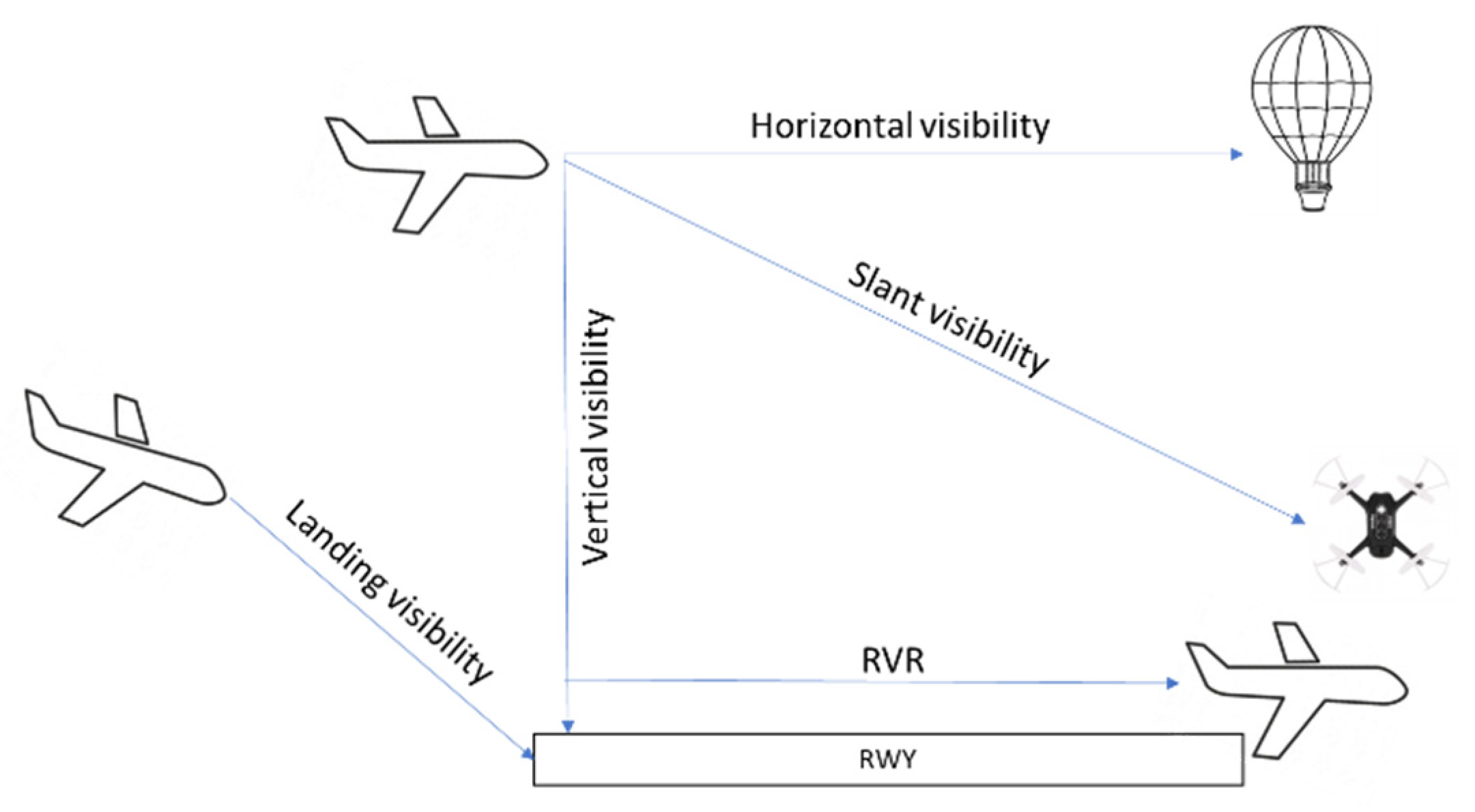
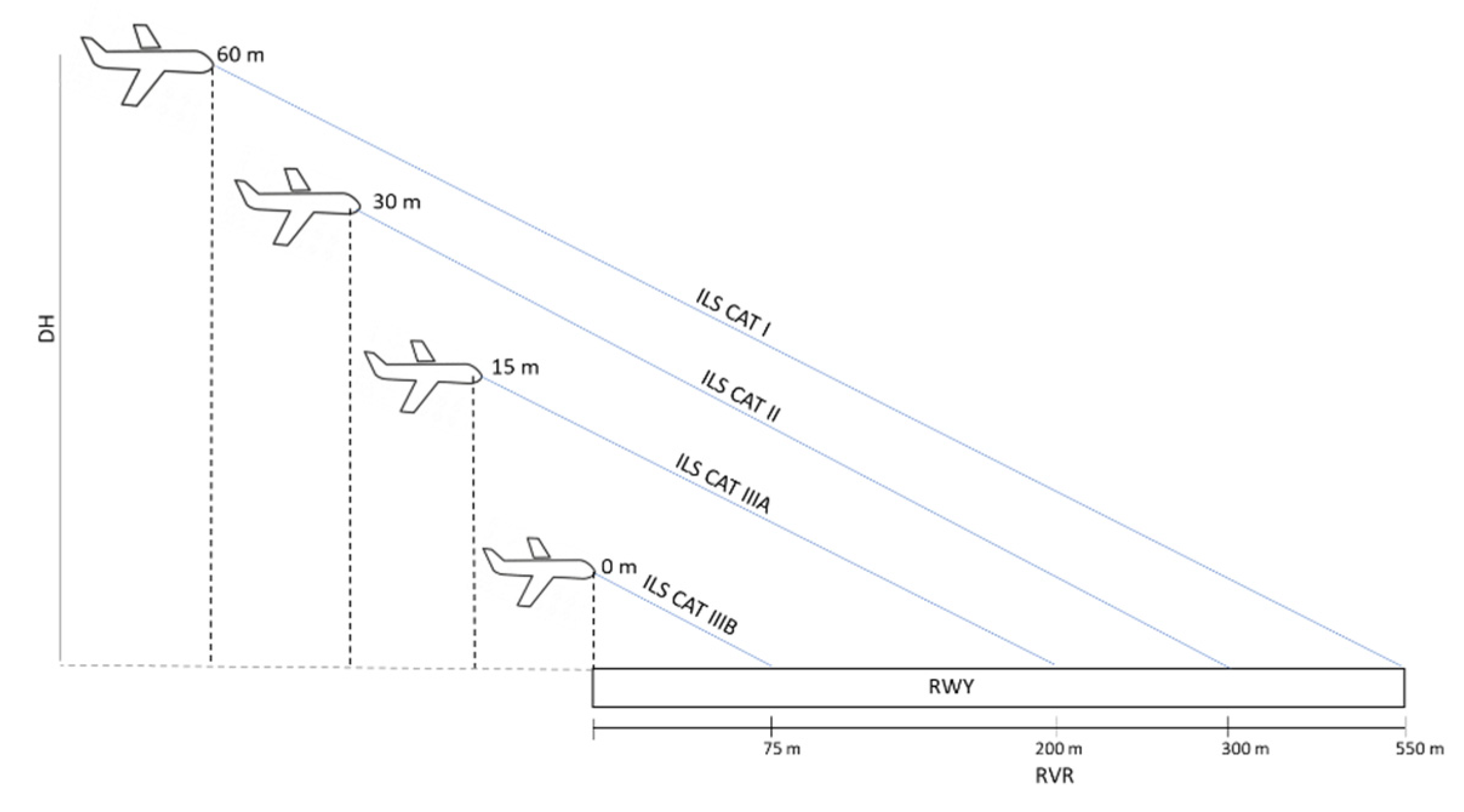

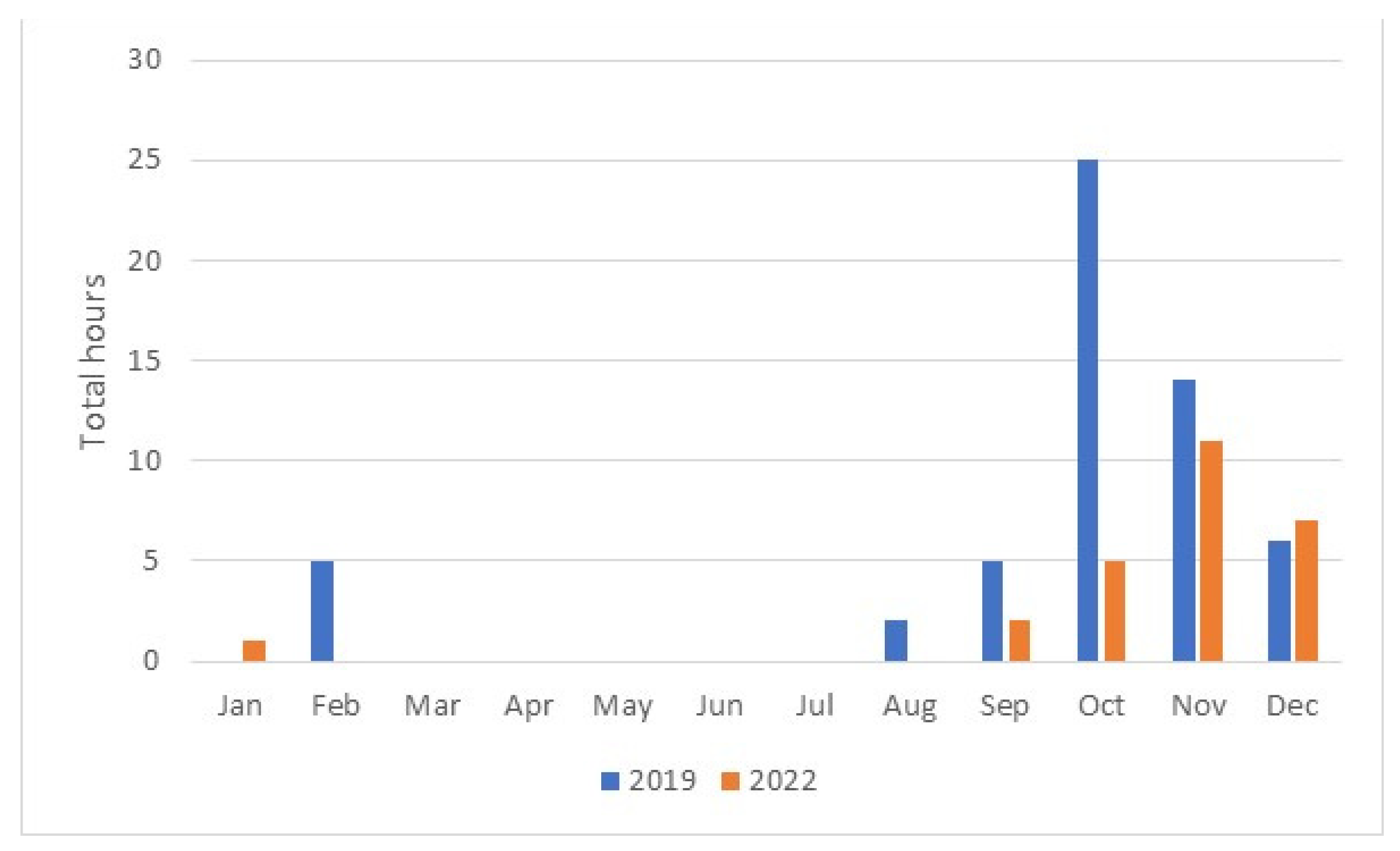



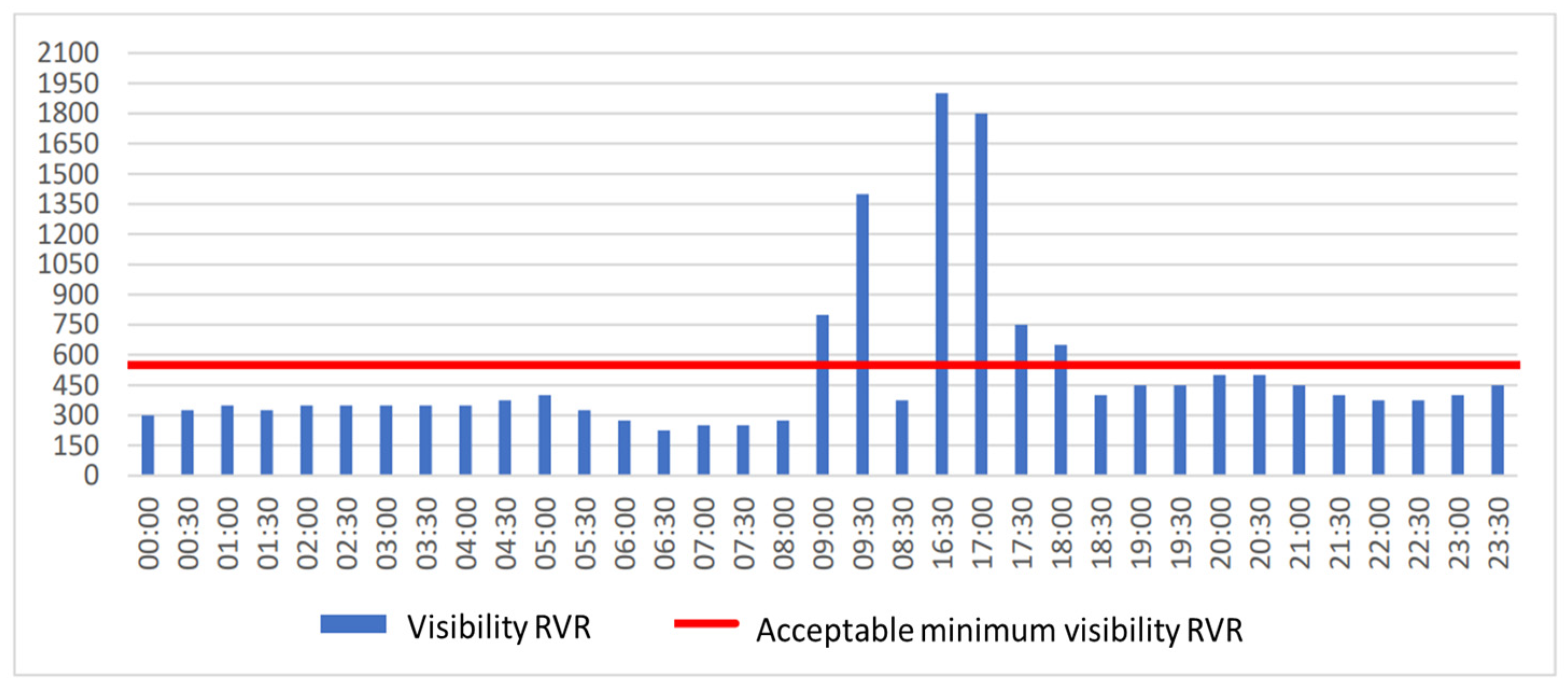

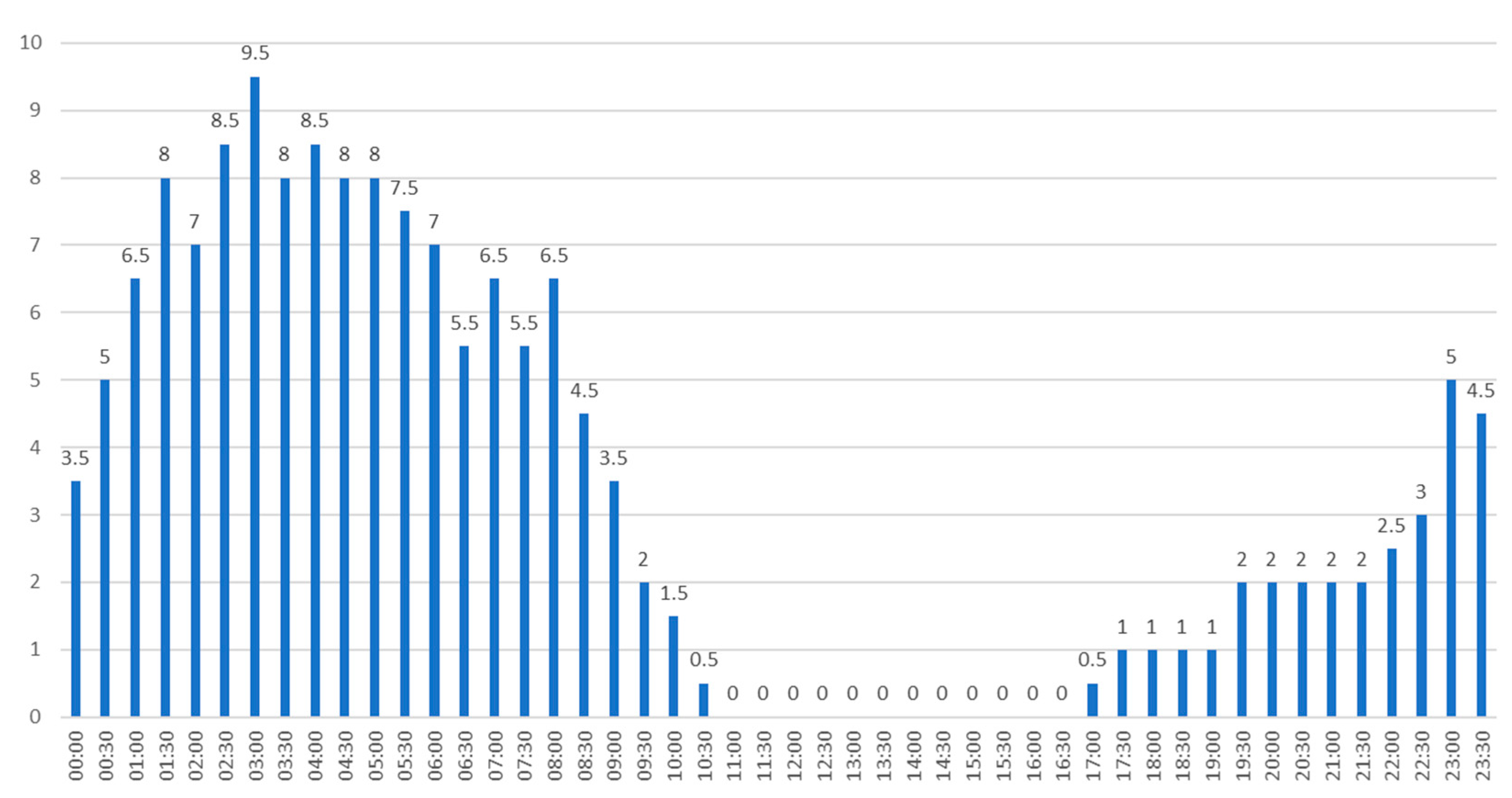

| The Phenomena | Visibility (km) | ||
|---|---|---|---|
| Poor Intensity | Middle Intensity | Strong Intensity | |
| drizzle | 3–2 | 2–1 | <1 |
| light rain | 10–6 | 6–4 | <1 |
| rain | 5–4 | 4–2 | 2–1 |
| snow | >3 | 3–1.5 | 1.5–0.5 |
| haze | 10–4 | 4–2 | 2–1 |
| fog | 1–0.5 | 0.5–0.2 | <0.2 |
| Airport | Category of ILS | Code ICAO |
|---|---|---|
| Kraków | I | EPKK |
| Modlin | II | EPMO |
| Chopin | IIIA | EPWA |
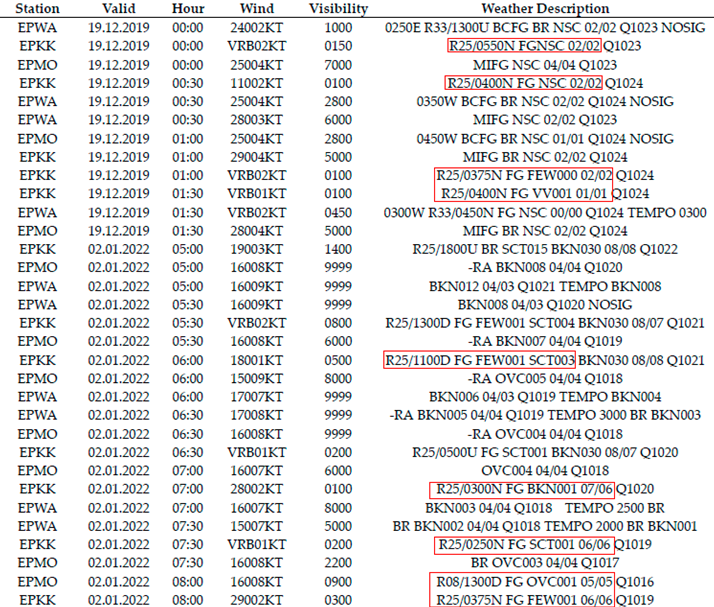 |
| Hours | Cat. I | Cat. II | Cat. IIIA |
|---|---|---|---|
| 0:00–2:00 | 10.0 | 6.67 | 6.67 |
| 2:00–4:00 | 12.92 | 4.58 | 4.58 |
| 4:00–6:00 | 11.25 | 4.17 | 4.17 |
| 6:00–8:00 | 9.58 | 5.00 | 3.33 |
| 8:00–10:00 | 7.92 | 3.33 | 3.33 |
| 10:00–12:00 | 1.67 | 0.42 | 0.42 |
| 12:00–14:00 | 0.00 | 0.00 | 0.00 |
| 14:00–16:00 | 0.00 | 0.00 | 0.00 |
| 16:00–18:00 | 1.25 | 0.83 | 0.83 |
| 18:00–20:00 | 3.33 | 3.33 | 3.33 |
| 20:00–22:00 | 5.00 | 4.58 | 4.58 |
| 22:00–24:00 | 8.75 | 5.83 | 5.83 |
Disclaimer/Publisher’s Note: The statements, opinions and data contained in all publications are solely those of the individual author(s) and contributor(s) and not of MDPI and/or the editor(s). MDPI and/or the editor(s) disclaim responsibility for any injury to people or property resulting from any ideas, methods, instructions or products referred to in the content. |
© 2023 by the authors. Licensee MDPI, Basel, Switzerland. This article is an open access article distributed under the terms and conditions of the Creative Commons Attribution (CC BY) license (https://creativecommons.org/licenses/by/4.0/).
Share and Cite
Kwasiborska, A.; Grabowski, M.; Sedláčková, A.N.; Novák, A. The Influence of Visibility on the Opportunity to Perform Flight Operations with Various Categories of the Instrument Landing System. Sensors 2023, 23, 7953. https://doi.org/10.3390/s23187953
Kwasiborska A, Grabowski M, Sedláčková AN, Novák A. The Influence of Visibility on the Opportunity to Perform Flight Operations with Various Categories of the Instrument Landing System. Sensors. 2023; 23(18):7953. https://doi.org/10.3390/s23187953
Chicago/Turabian StyleKwasiborska, Anna, Mateusz Grabowski, Alena Novák Sedláčková, and Andrej Novák. 2023. "The Influence of Visibility on the Opportunity to Perform Flight Operations with Various Categories of the Instrument Landing System" Sensors 23, no. 18: 7953. https://doi.org/10.3390/s23187953






